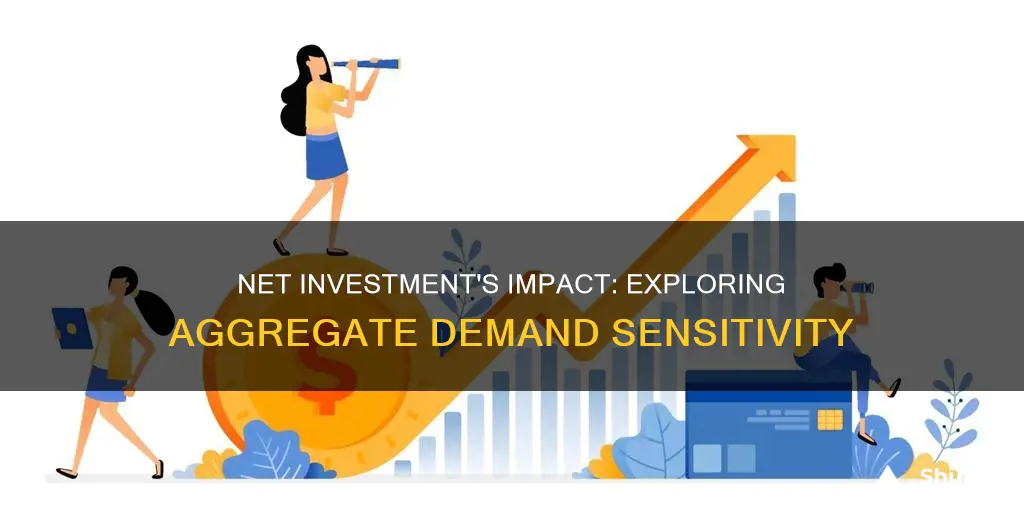
An increase in net investment will have a direct impact on aggregate demand, which is the total demand for all finished goods and services in an economy. Investment is a key component of aggregate demand, alongside consumer spending, government spending, and net exports. When businesses invest, they are spending on new capital assets, such as equipment and facilities, to support current output and increase production capacity. This investment spending can make up a significant portion of aggregate demand, and an increase in investment will therefore lead to an increase in aggregate demand, assuming all other factors remain constant. This increase in aggregate demand can lead to higher economic growth and potentially inflation, especially if there is spare capacity in the economy.
| Characteristics | Values |
|---|---|
| Effect on aggregate demand | An increase in net investment will lead to a rise in aggregate demand |
| Effect on economic growth | An increase in net investment will lead to higher economic growth |
| Effect on inflation | An increase in net investment may lead to inflation |
| Effect on output | An increase in net investment will lead to a rise in output |
| Effect on income | An increase in net investment will lead to a rise in income |
| Effect on spending | An increase in net investment will lead to a further rise in spending |
| Effect on aggregate supply | An increase in net investment will lead to an increase in aggregate supply in the long run |
| Effect on productive capacity | An increase in net investment will lead to an increase in productive capacity in the long run |
What You'll Learn
- Increased investment can lead to higher economic growth and inflation
- A rise in net investment can cause a knock-on effect throughout the economy
- Effective investment can help increase the long-run trend rate of economic growth
- Investment is a component of aggregate demand, accounting for 15% of it
- A shift to investment could lead to lower consumption in the short term

Increased investment can lead to higher economic growth and inflation
An increase in net investment can have a significant impact on aggregate demand, leading to higher economic growth and inflation.
Firstly, increased investment can lead to higher economic growth. This occurs when businesses invest in capital goods, such as machinery, equipment, and technology, which boost operational efficiency and labour productivity. This, in turn, leads to an increase in the production of goods and services, which is a key driver of economic growth. For example, the internet, a product of technological capital investment, contributed to 21% of GDP growth between 2006 and 2011.
Additionally, investment in infrastructure can also improve long-term economic growth. For instance, public investment in improving road networks can reduce congestion, making the transportation of goods and services more efficient and cost-effective.
Furthermore, increased investment can also lead to higher inflation. Inflation occurs when there is an increase in the supply of money relative to the level of productive output in the economy, causing a general rise in prices. When businesses invest, they often require loans, which increases the supply of money in the economy. As a result, there is more money chasing relatively fewer goods, leading to a rise in prices, which is the rate of inflation.
Moreover, investment can also contribute to inflation through the multiplier effect. An initial increase in investment leads to a rise in output and income, which is then spent, causing a further increase in aggregate demand. If the economy is already operating at full capacity, this increased demand will result in inflationary pressures without a corresponding increase in supply.
However, it is important to note that the impact of investment on economic growth and inflation depends on various factors, including the type of investment, the economic circumstances, and the opportunity cost of investment. For example, certain types of investment may become obsolete, such as the Sony MiniDisc, rendering them ineffective in boosting productive capacity. Additionally, in the short term, increased investment may lead to lower consumption as a higher share of GDP is devoted to investment rather than consumption.
Invest in Cars: Buyer's Guide
You may want to see also

A rise in net investment can cause a knock-on effect throughout the economy
Net investment is a component of aggregate demand (AD), which is a macroeconomic term for the total demand for all finished goods and services produced in an economy. AD is commonly expressed as the total amount of money exchanged for those goods and services at a specific price level and point in time.
An increase in net investment will cause a rise in AD, which will lead to higher economic growth and possibly inflation. If there is spare capacity in the economy, an increase in investment could cause a knock-on effect throughout the economy. This is because the initial increase in investment leads to a rise in output, which results in higher incomes for individuals. This, in turn, leads to more spending, causing a further rise in AD.
The strength of this knock-on effect depends on the multiplier effect. The multiplier effect suggests that the initial increase in investment may cause a bigger increase in AD in the long term. This is because the increase in income leads to more spending, which increases AD and economic growth.
In the long term, an increase in investment should also increase the productive capacity of an economy and, therefore, increase aggregate supply. This enables a more sustainable increase in AD without causing inflation.
However, it is important to note that the effectiveness of increased investment depends on the economic circumstances. For example, if there is a situation of falling house prices and lower consumer spending, increased investment may be insufficient to increase AD. Additionally, investment only accounts for around 15% of AD, so it can be outweighed by domestic consumption.
Invest in Crypto, Now
You may want to see also

Effective investment can help increase the long-run trend rate of economic growth
Effective investment can increase the long-run trend rate of economic growth. This is because investment is a component of aggregate demand (AD) and influences the productive capacity of the economy. An increase in investment can boost AD and short-run economic growth. If there is spare capacity in the economy, increased investment can cause a knock-on effect throughout the economy. This is known as the multiplier effect. The initial increase in investment increases economic growth, but if firms gain more sales and profit, they are willing to reinvest this in further investment. This can lead to higher real GDP without inflation.
The long-run trend rate of growth is the average sustainable rate of economic growth over a period of time. It is determined by growth in productive capacity, which is influenced by factors such as technological improvements, labour productivity, availability of resources, investment levels, and efficiency of investment. Effective investment can increase the productive capacity of the economy, for example, by investing in new technology and capital, or in skills and education to increase labour productivity. This can help shift long-run aggregate supply (LRAS) to the right, which is essential for long-term economic growth.
However, it is important to note that the impact of investment on economic growth depends on the economic circumstances and the type of investment. For example, if there is a fall in consumer spending or exports, an increase in investment may not actually increase AD. Additionally, some investments may be ineffective in boosting productive capacity, such as investing in obsolete technology. Furthermore, the rate of economic growth also affects the level of investment. Businesses tend to increase investment when they see an improvement in economic forecasts, while they cut back on investment during an economic downturn.
Investments: Paying with Potential
You may want to see also

Investment is a component of aggregate demand, accounting for 15% of it
Investment is a key component of aggregate demand (AD), making up about 15% of it. The other components are consumer spending (which makes up 61% of AD), government spending, and net exports.
Investment spending is money spent by businesses to support current output and increase production capability. This includes spending on new capital assets such as equipment, facilities, and raw materials. It also includes capital expenditure, such as purchasing machines or building a bigger factory.
As investment is a component of AD, an increase in net investment will lead to an increase in AD. This, in turn, will lead to higher economic growth and possibly inflation. If there is spare capacity in the economy, an increase in investment could have a knock-on effect throughout the economy. The initial increase in investment causes a rise in output, so people gain more income, which is then spent, causing a further rise in AD.
However, it is important to note that investment is a relatively small component of AD compared to consumer spending. Therefore, an increase in investment may not always be enough to increase AD, especially if there is a situation of falling house prices and lower consumer spending. Additionally, increasing the share of GDP devoted to investment in the short term could mean a lower share of GDP for consumption, as investment is financed out of savings.
LLCs: Why Investors Are Wary
You may want to see also

A shift to investment could lead to lower consumption in the short term
A shift towards investment could mean a reduction in consumption in the short term. This is because investment is financed through savings, so a higher share of GDP going towards investment implies a lower share for consumption. However, if the investment is successful, it can enable increased productive capacity in the long term.
The opportunity cost of investment is an important factor to consider. While investment spending accounts for about 15% of AD, consumer spending makes up 61%. This means that a shift towards investment can be outweighed by domestic consumption. For example, an increase in investment may be insufficient to increase AD if there is a situation of falling house prices and lower consumer spending.
The effectiveness of investment is another key consideration. Different types of investments can yield varying rates of return. For instance, investment in the Sony MiniDisc proved ineffective in boosting productive capacity as the technology became obsolete. Similarly, government-supported investment in the Concorde supersonic jet had a poor rate of return and was deemed unprofitable. On the other hand, public investment in improving road networks can help reduce congestion and boost long-term economic growth.
It's also worth noting that the components of aggregate demand, including consumption and investment spending, can be influenced by consumer and business confidence. When confidence is high, individuals tend to consume more, and firms are more inclined to spend on investment. Conversely, a drop in confidence leads to a decline in consumption and investment spending.
Stocks to Buy: Top Picks
You may want to see also
Frequently asked questions
The formula for calculating aggregate demand is:
> Aggregate Demand = Consumer Spending + Investment Spending + Government Spending + Net Exports
The components of aggregate demand are:
- Consumer spending on goods and services
- Private investment and corporate spending on non-final capital goods (factories, equipment, etc.)
- Government spending on public goods and social services (infrastructure, Medicare, etc.)
- Net exports (exports minus imports)
An increase in net investment will lead to an increase in aggregate demand. This is because investment is a component of aggregate demand, and when investment increases, aggregate demand will also increase, assuming all other factors remain constant.







